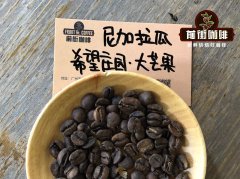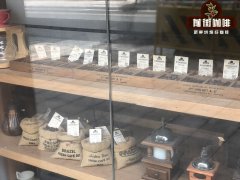Q-Grader How do you grade raw beans? How can coffee producers improve cup testing? Coffee scoring criteria

In the boutique coffee industry, high-grade coffee is cupped and scored by tasting / grading experts or Q graders. These scores can be used as quality control for the industry; they enable producers to determine whether their coffee is premium or commercial coffee and charge a fee accordingly.
Because the measured score of the cup will affect the value of coffee, they are very important indicators. Some producers who realize this have begun to rate their coffee in order to improve the quality and raise the selling price.
However, without the right training and experience, many people will end up unwittingly exaggerating coffee. This is an explanation of how excessive scoring occurs, the problems it may cause and how to solve them.
How and why did you score for coffee?
Coffee is usually cup-shaped according to specific criteria and is called a cup test protocol. The most commonly used protocols are those developed by the Professional Coffee Association (SCA). SCA best practices recommend tasting coffee samples and giving them a full score of 100 based on a variety of different parameters, including aroma, flavor and acidity.
Any defects are also graded and the number is subtracted from the total score to get the final number. To be considered a specialty, coffee must have a score higher than 80. It is then further classified as outstanding (90 or higher), excellent (85-89) or very good (80-84).
Producers, buyers, roasters and baristas all rely on cups to measure scores. They use it to decide which coffee to buy, call in the baking profile, and bring new and interesting flavors to customers.
Although the cup test itself is very simple, being able to grade coffee accurately is a skill that takes time to develop. Most people will have to do dozens of cup tests to discover the nuances and flaws that coffee may have.

How does the unexpected coffee exceed the standard?
To drink coffee, all you need is coffee beans, filtered and temperature-controlled water, a grinder, scales and a timer. In addition, the cup scorecard is easily available on the Internet, which means that more or less anyone can brew coffee under some guidance (including the manufacturer). However, many producers who drink their own coffee have not received formal training on cup testing procedures.
Elisa Welchez is the general manager of Cafe Welchez in Honduras. She explained that, although the country advocated increased production, producers had not been educated on how to improve the quality of coffee or to follow appropriate cup testing procedures. As a result, many producers, especially in remote areas, do not have the skills needed to accurately evaluate and evaluate coffee.
Many producers can only use coffee from their own regions. If they cannot provide coffee from other countries and regions, the ability of producers to compare and compare different coffees will be limited. It can also make it impossible for producers to accurately evaluate coffee based on consumers' expectations of certain places of origin. In addition, it may affect their understanding of international trends and the needs of international audiences in coffee.
In the culture cup measurement technology, it is very important that the producer be able to compare its results with other cup detectors. This helps them to hone and implement different cup testing techniques. However, even if they can attend group cup testing meetings, it will be difficult for producers to discuss their results with other cup testers if they lack the vocabulary to evaluate and rate coffee.
All in all, these problems lead to one thing that happens when producers drink their own cup of coffee: the score is inaccurate and is usually higher than the actual score. This is the so-called "overrating".
What happens when coffee is heavier?
Too high a rating for coffee usually leads to quality problems. Ensei Neto, a coffee consultant for The Coffee Traveler, explains that this often happens in sample surveys: "sometimes samples are different from real batches because people prepare them in different ways and take out defective coffee to make better samples." This can lead to inaccurate scores and the price of coffee exceeds its value.

Too high a score can also blur the line between boutique coffee and commodity-rated coffee. For example, if a producer continuously rates his coffee as a special product when it is actually commodity-grade coffee, it may damage the producer's reputation. Most buyers will make a cup of coffee as soon as they receive it, and if the score between the sample and the delivered batch is different, it may affect the level of trust in the business relationship.
If producers are not trusted by buyers, their long-term financial stability is more likely to be threatened. If the score of the purchased batch does not match their sample score, the buyer is less likely to promise to repeat the purchase. This may even cause buyers to ask for a partial or full refund, resulting in further financial pressure.
How does the producer improve the cup test
The best way to prevent overgrading is to know it happens-most producers don't deliberately overrate their coffee.
These are four ways in which producers can make a cup of coffee more accurately.
1. Calibrate their taste with other coffee
The more producers are exposed to different types of coffee, the more they can compare and compare each type of coffee. This means that they can expand their understanding of misery and recognize characteristics that are usually associated with certain places of origin. If coffee is not available from other producing countries, producers can also calibrate their taste by cupping other producers' coffee, or try different varieties, processing methods and fermentation methods.
"Local producers should bring their coffee to [other farms] for discussion so that they can know more about the products they produce," Elisa said. This helps them to visit different coffee varieties and cups that have been treated differently. This will also support other members of the same production community, thus bringing better reputation to specific sources.
two。 Compare the results with other tragedies.
By filling a group of coffee cups, producers can understand different cup testing methods and techniques. Ideally, this will take place at international events, where manufacturers can learn how skilled cup testers provide accurate scores.
Producers should also seek training and education on cup testing, as it can teach them how to identify different coffee features, varieties and defects in the cup. It also means that they will be better prepared to discuss and clarify the taste of coffee.
However, high costs and practical restrictions prevent many producers from obtaining educational opportunities and participating in international activities. In this case, video call is a good choice. Buyers can invite producers to participate in remote cup testing meetings and share their insights and findings with each other. This will help producers gain in-depth knowledge and insights on how to generate cup test reports and implement feedback more effectively.
3. Improve the transparency of grading
Transparency is essential for enhanced communication and is an integral part of any good buyer-producer relationship. Although producers can and should rate their own coffee, they can build further trust by encouraging buyers to rate their own coffee.
Marcelo Flanzer, coffee director Ecoagricola, advises producers to "send samples with varieties, drying methods, crops, and some other information about coffee, not scores." This will enable the buyer to make coffee objectively.
After the buyer has packed the coffee cup, the producer can also compare its score with the buyer's score and ask questions about how and why certain conclusions have been drawn. The producer can perform any relevant feedback.
4. Abide by a single cup test protocol
Although SCA's cup test protocol is the most widely used, other protocols do exist. In order for potential buyers to understand the producer more clearly, the producer should follow an agreement and clearly communicate which agreement they are using.
Ensei points out that when different protocols are used for the same sample, a difference of 3 to 6 points is usually found in the score. Producers decide which agreement to follow, and they all need to ensure that the buyer's quality control team is aware of the agreement to prevent poor communication.
There are many factors that prevent producers from grading coffee better and more accurately. Although producers must be aware of the danger of over-scoring, buyers should also support them in making more accurate cups of coffee where possible.
When producers can accurately brew their own coffee, they can establish reliable long-term relationships with buyers. Since these relationships with buyers provide producers with a stable income, producers will be able to invest in their farms and eventually produce higher-scoring coffee.
Important Notice :
前街咖啡 FrontStreet Coffee has moved to new addredd:
FrontStreet Coffee Address: 315,Donghua East Road,GuangZhou
Tel:020 38364473
- Prev

Nicaragua boutique coffee New Segovia producing area Hope Manor Big Mango Flavor performance
Professional coffee knowledge exchange more coffee bean information please follow the coffee workshop (Wechat official account cafe_style) Nicaraguan coffee bean is one of the relatively minority coffee beans, Nicaragua's figure in the boutique coffee market is particularly inconspicuous. The quality of Nicaraguan coffee beans is stable, and the large beans have a unique almond flavor, and the components have been faithful by the boutique industry in recent years. Front street
- Next

Flavor difference between Honduran whisky barrel Shirley and brandy barrel litchi orchid coffee
Professional coffee knowledge exchange more coffee bean information Please pay attention to coffee workshop (Wechat official account cafe_style) Coffee bean wine barrel fermentation treatment is a new treatment in recent years, barrel fermented coffee beans will have an unprecedented flavor and taste experience. As the technology becomes more and more mature, the barrel fermentation method is becoming more and more popular.
Related
- Beginners will see the "Coffee pull flower" guide!
- What is the difference between ice blog purified milk and ordinary milk coffee?
- Why is the Philippines the largest producer of crops in Liberia?
- For coffee extraction, should the fine powder be retained?
- How does extracted espresso fill pressed powder? How much strength does it take to press the powder?
- How to make jasmine cold extract coffee? Is the jasmine + latte good?
- Will this little toy really make the coffee taste better? How does Lily Drip affect coffee extraction?
- Will the action of slapping the filter cup also affect coffee extraction?
- What's the difference between powder-to-water ratio and powder-to-liquid ratio?
- What is the Ethiopian local species? What does it have to do with Heirloom native species?

